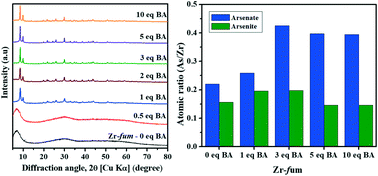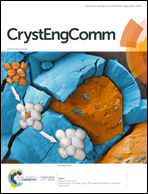Synthesis of modulator-driven highly stable zirconium-fumarate frameworks and mechanistic investigations of their arsenite and arsenate adsorption from aqueous solutions†‡
Abstract
Here, we synthesized a modulator (benzoic acid (BA))-driven zirconium-fumaric acid (Zr-fum) metal–organic framework (MOF) and investigated in detail the adsorption mechanism of arsenic oxyanions (AsO43− and AsO33−) and their stability before and after adsorption from water. Without the support of the modulator, BA, Zr-fum formed an amorphous MOF due to the occurrence of quick precipitation of both zirconium and -fum. Various amounts of BA, 0–10 eq. to ZrCl4, were used to control the surface charge on the MOF nanoparticles, which directly corresponds to the colloid stability of the MOF and helps to obtain a defect-free Zr-fum MOF for high uptakes of AsO43− and AsO33− from water. With the concentration of 3 eq. BA, the adsorption capacities of both arsenic oxyanions on the Zr-fum MOF were found to be higher than those on other MOFs. The CHN analysis indicated that the excess of -fum present does not alter the adsorption densities of AsO43− and AsO33− on MOFs in addition to the negligible amount of BA except for the Zr-fum-10 eq. BA MOF where it is present in higher amounts, as confirmed by NMR studies. The physicochemical properties of the synthesized MOFs with/without the modulator support adsorbents before and after the adsorption of AsO43− and AsO33− were extensively characterized using several advanced instrumental techniques. The maximum uptake performance of AsO43− (1.159 mmol g−1) and AsO33− (1.121 mmol g−1) was obtained using the Langmuir adsorption isotherm. The adsorption of both AsO43− and AsO33− takes place by electrostatic interaction/complexation and ligand exchange with Zr-fum-5 eq. BA. In addition, the Zr-fum-5 eq. BA was recycled up to four times at a sustained efficiency after washing with 0.1 M NaOH. Owing to their high uptake capacities of AsO43− and AsO33−, the synthesized MOFs are expected to have potential applications as adsorbents for practical applications.



 Please wait while we load your content...
Please wait while we load your content...